Coffee is a wonderful thing. Half of the world seems to run on its caffeinated goodness. How else are we supposed to kick-start our mornings? The trouble with coffee, for me at least, is the bitterness… and the flavour. It tastes like you’re drinking hydrochloric mud!
Fortunately for me, there is another way to get the requisite caffeine on board: cola. My preference is Pepsi Max, although any cola does the trick. Not as well as coffee, though. Oh no. Coffee typically has four times as much caffeine as an equivalent measure of cola. This might go some way to explaining why I’m so grumpy in the mornings…
But I’m far from alone with my dislike of the natural favour of coffee. This flavour, however, can be mellowed by adding things to it, and that, generally speaking, is where the trouble with coffee begins.
Coffee has been drunk for it’s stimulating properties for more than 500 years. For the vast majority of that time, it was just ground coffee beans in hot water. And that was fine. Wide awake with zero calorific intake. That’s right, simple coffee has no calories.
And why would it? Coffee starts life as the seed of a berry:
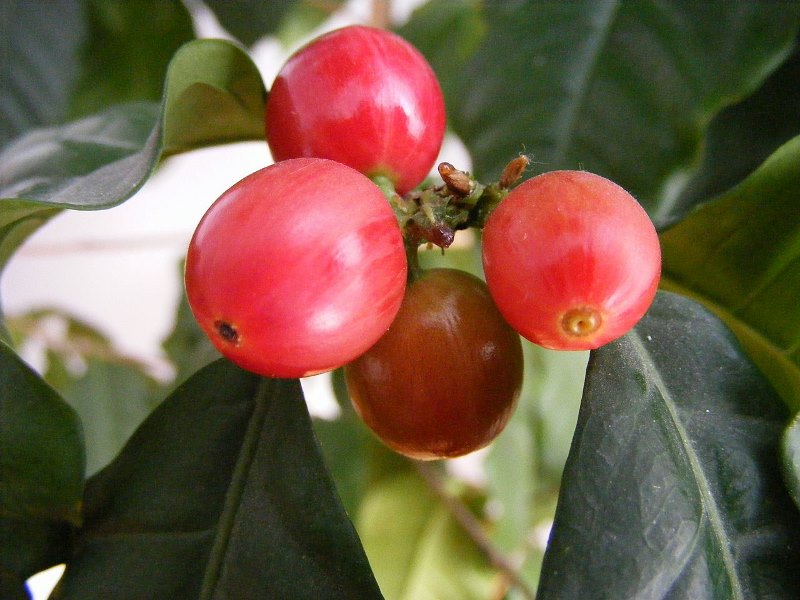
The flesh of the berry is removed and then the remaining, somewhat slimy, seeds are fermented to remove this mucilage. The seeds are then thoroughly washed to clean them. This process uses a huge amount of water and generates a similarly large amount of coffee wastewater, which is considered a type of industrial water pollution. And this is on top of the 140 litres of water it takes to grow enough coffee beans to make a single cup of coffee.
The trouble with coffee production is, the amount of water needed to grow it is often incompatible with the places it can be grown. Ethiopia, for example, is a major coffee exporter, which, famously, struggles with droughts. A difficult position to be in.
But, back to the coffee. The seeds are then dried and become referred to as coffee beans. In this instance, green coffee beans. Or green coffee.
There are a number of ways to dry the coffee beans. The best way is, the traditional African way, of using raised drying beds. The beds allow the air to evenly dry the beans on all sides, giving the most uniform flavour. Other techniques include spreading the beans on the ground and raking them over, to allow the sun to get at all sides. There’s also a mechanical option of, basically, tumble drying the beans…
And then there’s Kopi Luwak coffee, about the most expensive coffee in the world. This is processed by having the coffee fruit eaten by the Asian Palm Civet, and then picking the beans from its faeces. Yep, it’s crap coffee, all right; even by coffee standards!
A Civet, Asian Palm or otherwise, can be best considered as a cross between a cat and a monkey:
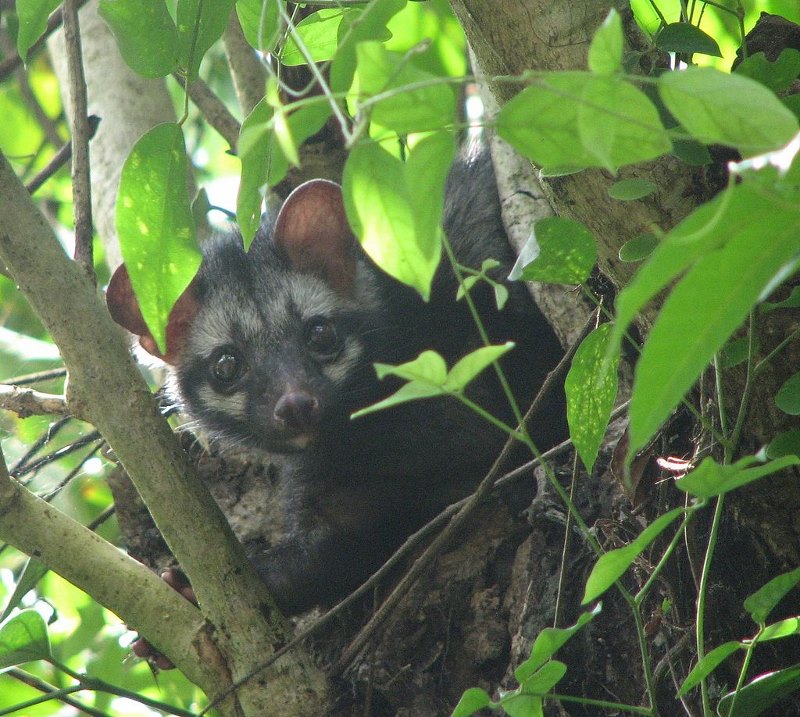
But before the bean can get anywhere near the cup, it needs to undergo its most important process: roasting.
The beans need to be roasted to at least 200°C. At this point the starches convert to sugars, which then begin to caramelise, giving the beans their brown colouring. The more the beans are roasted, the darker the colour achieved. Also around this temperature, the oils in the bean begin to become altered and, again, these oils vary depending on the darkness of the roast.
It is the roasting process that produces the variety of flavours that allow coffee bores snobs connoisseurs to have their day.
Well, that and the type of bean. Of which there are only really two:
- Arabica Coffee (C. arabica)
- Robusta Coffee (C. canephora)
Arabica is considered the ‘better’ coffee and, as such, makes up three quarters of all cultivated coffee. Robusta, on the other hand, is considered to be more bitter, but with ‘better body’, whatever that means. Robusta does, however, have more caffeine that Arabica, which should be all you need to know if you’re just after a stimulant.
Actually, as well as the roasting process and the type of bean, there’s also where the bean is grown. This, too, can influence the flavour of the resulting coffee. The coffee plant was originally native to tropical Africa but is now grown in more than 70 countries across the world. Various regions have then developed their own subspecies of Arabica and Robusta to generate specific regional coffees like Java and Kona. It’s basically a connoisseur’s paradise.
And, from roasting, it’s a simple step from there to the cup, right? I wish! Without getting bogged down in the various ways that coffee can be chopped. sliced and ground for brewing, I’m just going to jump straight to how it is bought in the supermarkets.
Because, for someone of my age, from my country, buying coffee means one thing:
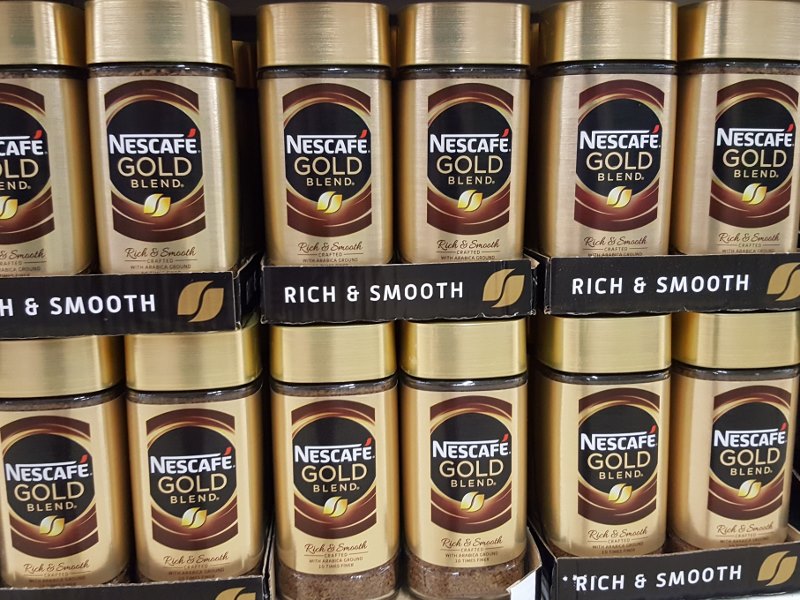
Now, of course, Gold Blend is just one of a dizzying array of instant coffees. And the, once famous, set of 12 serialised adverts, that launched Anthony Stewart Head to Buffy fame, are all but forgotten. But instant coffee, which is simply dried or freeze-dried brewed coffee, is now sneered at by many coffee bores snobs connoisseurs. Despite there being relatively little difference in taste.
Nonetheless, this attitude has allowed for more marketing and sales options to appear in supermarket shelves.
There are the vacuum packed ground coffees, for use in percolators, cafetieres and the like:
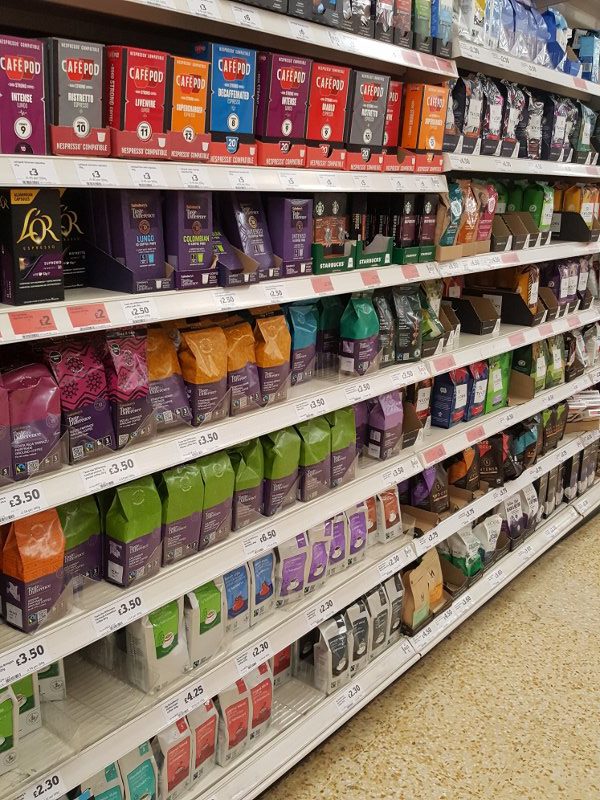
These are sachets of pre-mixed barista style coffees. Simply add boiling water and stir:
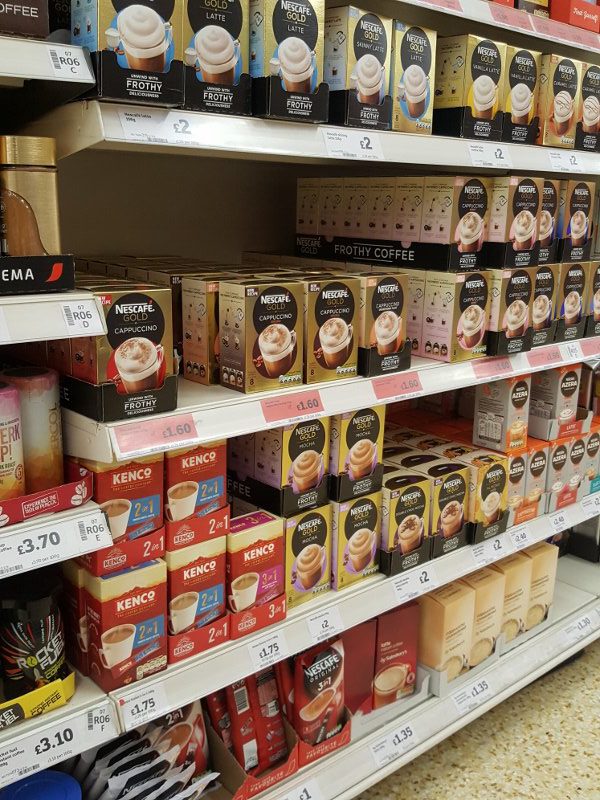
Most recently, with the advent of pod coffee machines, are the capsules that feed them. High concentrated liquid forms of a variety of barista style coffees. Simply click into a machine, which will add hot water on your behalf:
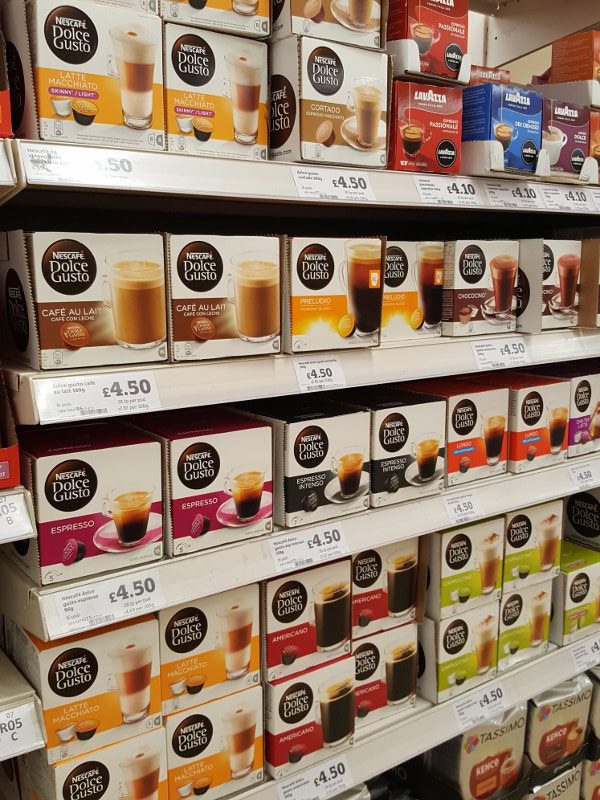
And then finally, cold versions of the actual barista style coffees that you can buy in coffee shops like Starbucks. Plus some equivalent products:
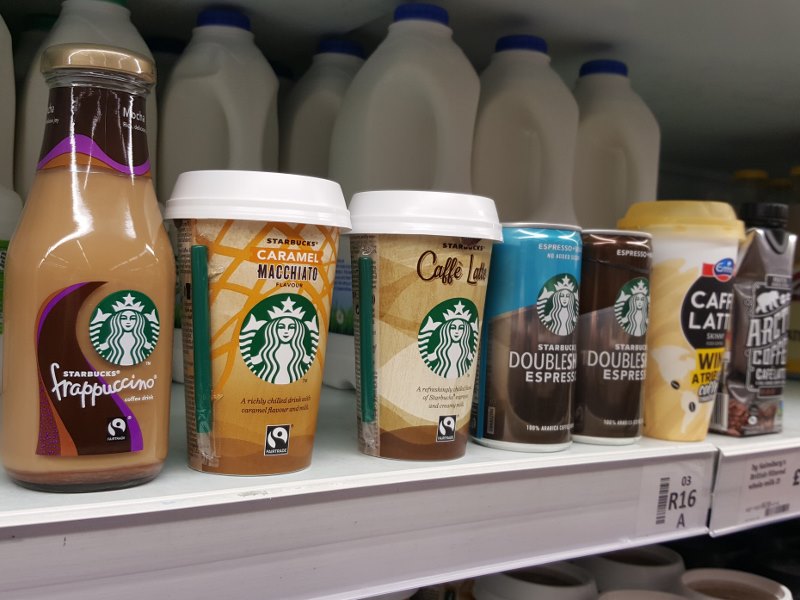
The stupefying range of instant and ground coffees, though, isn’t the trouble with coffee. These products are still, more or less, pure coffee and calorie free.
A number of studies have even shown that drinking coffee is actually good for you; beneficial to your health. Four cups a day seems to be the magic number. At four cups a day, providing you don’t have any underlying health issues and aren’t drinking alcohol to excess or smoking, coffee consumption is associated with a lower risk of death.
Seriously!
Those who drink coffee live longer than those who do not. It is thought that coffee drinkers have a lower risk of:
- Cardiovascular Disease
- Parkinsons Disease
- Type II Diabetes
So, coffee drinkers tend to live longer and pick up fewer of certain types of diseases. Which is great news. Right up until you get to the bottom three of the above pictures, which is where the trouble with coffee kicks in.
Much like with chocolate, it isn’t the actual coffee that’s the problem; it’s what’s added to it.
A sachet of the Necafe Gold Cappuccino carried 66 calories. Which isn’t too bad, in the great scheme of things. A coffee made from the Dulce Gusto Cappuccino capsules has 89 calories. Again, while not as good as an instant or ground coffee, not the end of the world.
The pot of iced Starbucks Cafe Latte, is 220 ml. It comes in at 70 calories per 100 ml. So that Cafe Latte (Milky Coffee) is 154 calories.
That’s quite a lot.
Of the other iced products in the photo:
- Mocha Frappuccino (250 ml) – 160 calories
- Caramel Macciato (220 ml) – 136 calories
- Doubleshot Expresso, no added sugar (200 ml) – 100 calories
- Doubleshot Expresso (200 ml) – 142 calories
- Emmi Caffe Latte (230 ml) – 145 calories
- Arctic Coffee, Cafe Latte (330 ml) – 182 calories
These are also quite a lot. Especially the Arctic Coffee, Cafe Latte. This includes 25g of sugar. Which is 5 teaspoons. This is listed, in the nutritional information of the drink, as 28% of the recommended daily intake of sugar. This despite the NHS recommendation of, no more than 30g of free sugar a day. Free sugar being defined thus:
Free sugars are found in foods such as sweets, cakes, biscuits, chocolate, and some fizzy drinks and juice drinks
Personally, I’m happy to count iced coffee drinks as qualifying as part of this definition.
And that’s part of the trouble with coffee. It’s being made sweeter and more accessible. The reason for this is that sweeter things appeal to a younger market.
Adults already drink coffee. If you want to expand your market, the only option is to go younger. Youngsters are well known for not liking bitter tasting foods and drinks. The solution: sweeten them.
But how much sugar do you have to add to something as bitter as coffee to make it appealing to a child’s palette? How much, indeed!?

As Starbucks has already made an appearance here, thanks to its iced drinks on the shelves in Sainburys, I’ll start there.
As you’d expect, the standard coffees, those we could say are aimed at adults, have a reasonable amount of calories in them. In terms of the cappuccinos, when made with the standard semi-skimmed milk, they range from:
- 68 calories for a Short, to;
- 201 calories for a Venti.
But when you get to, what can reasonably expected to be considered as children’s drinks, things change substantially. For a start, whole milk is used instead of semi-skimmed as standard. For another, whipped cream and a syrup topping also become standard. As such the Strawberries and Cream Frappaccino ranges from:
- 224 calories, with 24g of sugar, for a short, to;
- 390 calories, with 48g of sugar, for a Grande.
At least they don’t do a Venti in this drink.
This, incidentally, isn’t the most calorific option on offer, there’s a Java Chip version where the Grande has 448 calories and 59g of sugar.
I should also point out that the hot and cold chocolate drinks can be just as bad, or worse, so don’t look there for a healthier option.
This information is publicly available, if you’re so inclined to look. But it’s not that easy to read and does take some ploughing through.
The options at Costa follow a similar pattern. And while the information is better presented in terms of column headings, it is still not an easy read.
Perhaps unsurprisingly, MacDonalds have also got in on the act. In their McCafe range, they have the Mocha Coffee Frappe. This has nutritional values of:
- 420 calories, with 54g of sugar, for a small;
- 510 calories, with 66g of sugar, for a medium, and;
- 670 calories, with 89g of sugar, for a large.
All of the above mentioned products are technically coffees. All of them carry some level of caffeine. But 89g of sugar should be enough to hide the bitterness of coffee from even the fussiest child’s taste buds.
And just in case you’re worried that you can’t reproduce this sugary mess at home, don’t worry, they’ve got you covered:
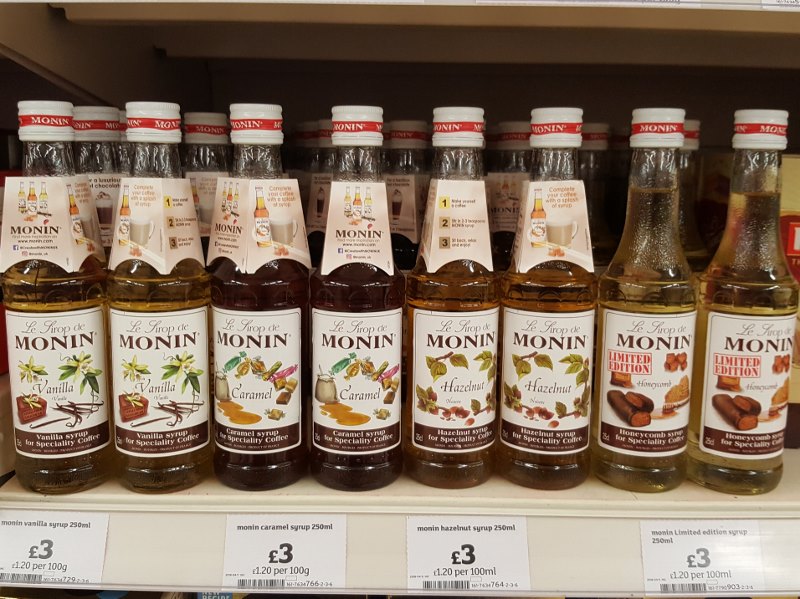
For children, the trouble with coffee is that it is being targeted at you in a ridiculously sweet format. And, once you’re used to taking your coffee like that, how will you drink it as an adult?
The trouble with coffee for parents is that your kids are being targeted with drinks, calling themselves coffees, that can carry as much as 670 calories and 89g of sugar. No doubt there are even worse offenders out there somewhere.
The recommended daily sugar allowance for children is as follows:
- 4-6 years old – 19g
- 7-10 years old – 24g
- Over 11 years – 30g
A small Starbucks Strawberries and Cream Frappaccino maxes out the sugar allowance of anyone under the age of 11.
A small MacDonalds Mocha Coffee Frappe is nearly twice the daily sugar allowance of an adult and nearly three times that of a 4-6 year old. The large version is equivalent to the sugar allowance of an adult for three whole days.
Therefore, the trouble with coffee, for everyone, is that, what is actually a healthy, even medically beneficial beverage, is being ruined with calories.
The ‘coffee’ drinks that our children consume simply add to the obesity problem. No one should be consuming that many calories, or that much sugar, in a drink. Certainly not a child.
The underlying problem with coffee is that it’s bitter. The solution is not to drown out the bitterness with an avalanche of sugar, so it can be fed to kids. Children don’t need a chemical stimulus; they’re kids! The trick is calming them down, not hopping them up…
Therefore, the solution is to not introduce your kids to coffee until they’re old enough to take on the challenge of adapting their taste buds to hydrochloric mud. If they need more than a spoon of sugar in a mug of coffee, they’re not ready for it. Especially if, as adults, they’re going to end up drinking four mugs a day… the trouble with coffee is; we need it!
